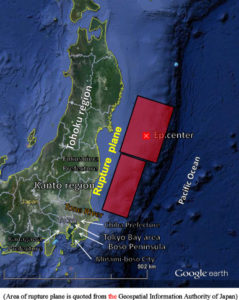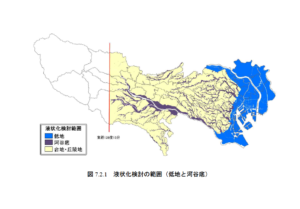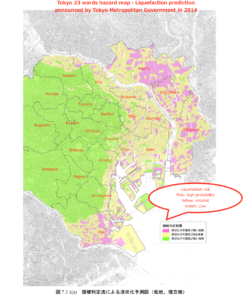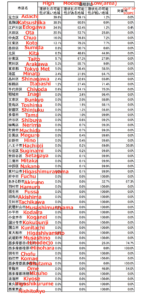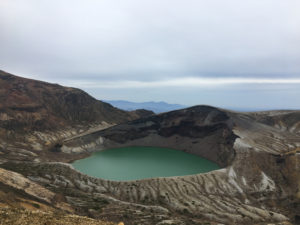
(Nebuta, Aomori)
Japan is subject to many wind and water related disasters due to the fact that much of the land is steeply inclined and experiences a lot of rain. In addition, typhoons also hit Japan from summer to fall.
Located in an area where many continental plates meet, Japan also experience earthquakes and volcanic eruptions.
Although Japan is a disaster-prone country, there is no need to be overly concerned.
We have some preparation measures. For example, here In Japan, every resident with a mobile phone receives a text message warning of imminent quakes.
Many disasters are small in scale, and Japan has accumulated knowledge on how to deal with disasters through past experience.
Secondary disasters that occur after the quake also characterize major earthquakes. If you and your property are near the coast, there may be a risk of tsunami.
According to an article in Economist in February 2018, in US,
“there is a 10% chance that in the next 30 years an earthquake between 8.0 and 9.0 in magnitude will rupture the Cascadia subduction zone that runs along the coast of Washington, Oregon and Northern California.
US has no early-warning system.
Mexico, Turkey, Romania, China, Italy, and Taiwan all have systems to warn residents of imminent earthquakes.”
My point is that natural disasters could happen anywhere in the world and thus preparation is very critical.
Many foreign investors ask us about the liquefaction risk in Tokyo area.
Today I am going to discuss the risk of liquefaction caused by the earthquake in Tokyo citing the information released by the local governments.
The 2011 Great East Japan Earthquake caused the severe liquefaction of reclaimed lands in the Tokyo Bay area, from Shinkiba (新木場)in Tokyo through Urayasu(浦安), Ichikawa(市川) and Narashino (習志野 to Chiba city (千葉市).
According to a paper ‘Characteristics of liquefaction in Tokyo Bay area by the 2011 Great East Japan Earthquake’
By Sumu Yasuda, Kenji Harada, Keisuke Ishikawa, Yoshiki Kanemaru in October 2012 :
Quote
The 2011 Great East Japan Earthquake, with a magnitude of Mw=9.0, occurred in the Pacific Ocean about 130 km off the northeast coast of Japan’s main island on March 11, 2011. The hypocentral region of this quake was about 500 km in length and 200 km in width. The quake was followed by a huge tsunami that destroyed many cities and killed and injured many people along the Pacific Coast. The numbers of dead and missing persons as of July 11, 2012 were 15,867 and 2909, respectively. The tsunami broke the emergency cooling system of a nuclear power plant in Fukushima Prefecture, and large areas of Japan have been plagued by radiation and a shortage of electricity ever since. In the geotechnical field, many houses and lifelines were damaged by soil liquefaction, landslides occurred, dams failed and river dikes settled not only in the Tohoku district of northeastern Japan, but also in the Kanto district, which surrounds Tokyo. Liquefaction occurred over a wide area of reclaimed lands along Tokyo Bay, although the epicentral distance was very large, about 380–400 km,
Unquote
(Taken from a paper ‘Characteristics of liquefaction in Tokyo Bay area by the 2011 Great East Japan Earthquake)
liquefaction in Tokyo Bay area by the 2011 Great East Japan Earthquake
In the meantime, the earthquake resistance standards (and fire protection) of buildings are strictly regulated by the “Building Standards Act” in Japan, and new buildings can not be constructed unless it meets this standards, and materials used are subject to authorization by the authorities.
Furthermore, the earthquake resistance standards are classified into three types, “earthquake-resistant structure”, “damping structure” and “seismic isolation structure”.
From the earthquake-proof structure that enhances the strength of walls and pillars to newer technologies such as damping and isolation And that the transition is progressing.
As examples of base isolation and damping, we introduce rubbers and shock absorbers using ball bearings installed at the bottom of high-rise buildings. He also mentioned techniques such as using beams combining steel and wood to enhance strength even in wooden buildings.
Japan’s earthquake-resistant technology is definitely at the top-level of the world.
Number of academic researchers and engineers is abundant,
WORLD CONFERENCE ON EARTHQUAKE ENGINEERING(WCEE) is held worldwide every 4 years and one-third of the papers for WCEE comes from Japan.
So what is the risk of liquefaction in greater Tokyo (meaning Tokyo, Kanagawa, Chiba and Saitama) area ?
Informed knowledge and advance preparation are important for the savvy real estate
investment.
Let’s look at the hazard map released by the Tokyo metropolitan government in 2012.
Tokyo Metropolitan Government updated the liquefaction prediction map in 2012 based on a number of scientific analysis, boring explorations, past phenomena caused by the previous major earthquakes including the great east Japan earthquake
in 2011.
(Please click to enlarge the image)
Tokyo liquefaction area map
The above shows the area map in terms of hight in Tokyo metropolitan.
The blue area indicates the ‘lowland’.
The yellow and purple indicate ‘plateau’ (highland) and bottom of valley
respectively.
Majority of the land (in yellow) in Tokyo is on the plateau called ‘Musashionodaichi’.
Scientifically, it is said lowland tend to have more risk of liquefaction.
Therefore the Tokyo bay area such as Minato, Chuo Ota and Shinagawa and the eastern part of Tokyo such as Adachi, Sumida
,Arakawa and Edogawa are more vulnerable to the liquefaction.
(Please click to enlarge the image)
Tokyo-hazard-map-LIQUEFACTION
The above map shows the vulnerability to the liquefaction of each area in Tokyo which was updated in 2012 by Tokyo
Metropolitan Government (the attachment image used to say 2014 but it has been corrected. 2012 is correct)
The pink area has the higher probability of the liquefaction and
yellow has the modest probability and the area in green has low probability.
The area based on the plateau is less risky towards the liquefaction and
the areas located in the lowland (eastern part of Tokyo 23 wards such as Adachi-ward, Katsushika-ward and Edogawa-ward) has higher risk.
All central wards such as Minato, Chuo and Shinagawa are ranked in the modest risk band.
Places in green such as Shibuya, Shinjuku, Meguro, Setagaya, Bunkyo and Suginami are ranked as the low risk area.
For more details, please refer to the following chart which was announced
by the Tokyo Metropolitan Government (updated in 2012).
(Please click to enlarge the image)
tokyo liquefaction each ward
As I said earlier, there is no need to be overly concerned but if you are
thinking of buying a house or rental property for the investment,
you should ask your agents information about the risk of natural disasters where your intended location is situated.
Sadly, in reality not many real estate agents in Japan are willing to discuss such risks in details as it might curtail their business opportunities.
So you as an investor need to be prepared by learning and collecting the reliable information and select more trustworthy real estate agents.
I illustrate the links showing the hazard map for each ward/city in Tokyo and surrounding cities
such as Yokohama as below (all in Japanese only)
Tokyo Metropolitan liquefaction prediction report in 2012
Tokyo hazard map liquefaction for each ward and city in 2012
Hazard map for earthquake Chiyoda-ward
Hazard map for liquefaction, Shinjuku-ward
Hazard map for liquefaction, Adachi-ward
Hazard map for liquefaction, Edogawa-ward
Hazard map for liquefaction, Yokohama-city
Hazard map Kawasaki-city
Hazard map (earthquake, fire and liquefaction) Chiba-city
Hazard map for liquefaction, Saitama-city
(Zao, Okama, Aomori)
Toshihiko Yamamoto
Real estate investing consultant and author.
Founder of Yamamoto Property Advisory in Tokyo.
International property Investment consultant and licensed
real estate broker (Japan).
He serves the foreign companies and individuals to buy and sell
the real estates in Japan as well as own homes.
He holds a Bachelor’s degree in Economics from
Osaka Prefecture University in Japan
and an MBA from Bond University in Australia
Toshihiko’s book, “The Savvy Foreign Investor’s Guide to Japanese Properties: How to Expertly Buy, Manage and Sell Real Estate in Japan”is now out on Amazon, iBooks (iTunes, Apple) and Google Play.
About the book
Amazon.com Link

